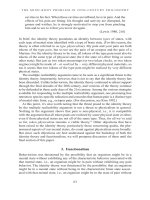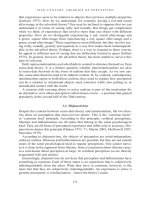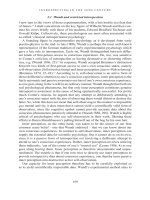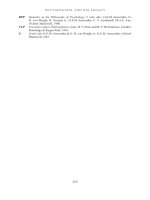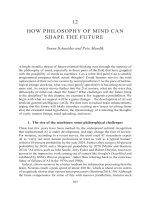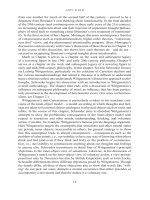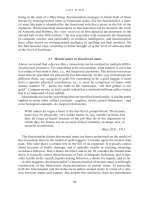Philosophy of mind in the twentieth and twenty first centuries the history of the philosophy of mind volume 6 ( PDFDrive ) (1) 178
Bạn đang xem bản rút gọn của tài liệu. Xem và tải ngay bản đầy đủ của tài liệu tại đây (171.31 KB, 1 trang )
I ntrospecting in the 2 0 th century
2.1 Wundt and restricted introspection
I now turn to the views of these experimentalists, with a less hostile eye than that
of James.11 I shall concentrate on the key figure of Wilhelm Wundt and then contrast his views briefly with those of his students, Edward Bradford Titchener and
Oswald Külpe. Collectively, these psychologists are most often associated with
so-called ‘classical introspectionist psychology’.
A founding figure in experimentalist psychology as it developed from early
psycho-physics in the mid- to late-1900s, Wundt is perhaps the most well-known
representative of the German tradition of early experimentalist psychology which
gave a key role to introspection. Early on, Wundt distinguished between different kinds of first-person access to conscious experience. He, too, was sensitive
to Comte’s criticism of introspection as having destructive or distorting effects
(see, e.g. (Wundt 1896, 25).12 In response, Wundt accepted Brentano’s distinction
between two kinds of first-person access to one’s own conscious states, namely
self-observation (Selbstbeobachtung) and inner perception (innere Wahrnehmung)
(Brentano 1874, 35–42).13 According to it, self-observation is an active form of
direct deliberative attention to one’s conscious experiences; inner perception is the
fairly automatic and passive awareness one has of one’s own conscious experience,
as one goes along in the world in an ordinary manner. Wundt thought that both are
real psychological phenomena, but that only inner perception constitutes genuine
introspective awareness in the sense of being epistemically successful. For pretty
much Comte’s reasons, he argued that any attempt at deliberately attending to
one’s conscious states with the aim of observing them would distort or destroy the
latter. So, while this does not mean that self-observing in this manner is impossible
qua mental activity, it does mean that it cannot yield a scientifically valid form of
observation, since the cognitive upshot cannot provide accurate data about the
conscious phenomenon putatively attended to (Wundt 1888, 296). Wundt is highly
critical of psychologists who use self-observation in their work, likening these
efforts to Baron Munchhausen’s pulling himself out of the bog by his own hair.
Inner perception, on the other hand, was taken to be the source of our firm
common sense belief – one that Wundt endorsed – that we can know about our
own conscious experiences. In contrast to self-observation, inner perception can
supply the essential data for scientific psychology. But it cannot do so on its own,
since it is a passive form of introspection not involving a deliberate attempt to
attend to one’s conscious experiences. Rather, inner perception involves noticing
them indirectly, ‘out of the corner of one’s “mental eye” (Lyons 1986, 4) as one
goes along having them. Inner perception is therefore unsystematic and unpremeditated. The trouble is that if one now tries to directly use inner perception to
provide introspective data about conscious experience, one thereby turns passive
inner perception into destructive active self-observation.
Our capacity for inner perception therefore has to be carefully exploited so
as to yield scientifically respectable data. Wundt’s experimental method aims to
159

